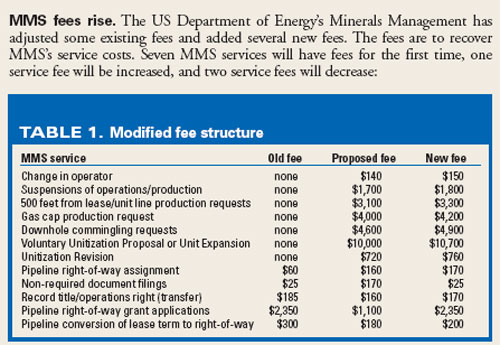What's new in production
Water damage. It looks like we have a real oil and gas production problem on our hands – Hurricane Katrina, nature’s ballerina, pirouetted up the Gulf of Mexico, twirled and blew away some of the industry’s equipment, not to mention clear-cutting offshore and onshore facilities in the US states of Louisiana, Mississippi and Alabama, as well as initiating the drowning of New Orleans. The GOM has received a one-two punch after Ivan (the Terrible) last year and Katrina this year! Now the industry begins, once again, the review and rebuilding of severely damaged equipment. Repairing bent metal and draining pools of seawater in tanks and facilities are the easy part. Searching out the hidden damage in surviving structures is the tough job. Production facilities are integrated sets of systems: structural, fluid handling, power distribution and control, as well as routine business systems for operational personnel. On offshore facilities, systems for navigation, mooring, buoyancy control, riser management, living quarters, food preparation, sanitation and safety must all be checked and certified before the production systems and rigs can return to service. For rigs and platforms that were awash in seawater, there are serious concerns about the wiring systems. Seawater is conductive and corrosive, making it a major challenge for electrical systems. It is insidious as well. It will flow, seep and settle into all connections and along any minor insulation openings. Capillary pressure assures that seawater and its salts will spread along any available path. This ability to permeate all parts of a facility creates major problem classes: corrosion, foreign particles, insulation degradation, lubricant removal, and contact damage (in air gaps), which can compromise wiring and components. Some components should be replaced including solid state contactors and starters, devices using semiconductors and transistors, circuit breakers, switches and fuses. Thorough cleaning, drying and testing of components are essential, and the original manufacturer should be consulted in some cases. To help the industry deal with this problem, the National Electrical Manufacturer’s Association has released a free publication “Guidelines for Handling Water Damaged Electrical Equipment,” available on their website: www.nema.org/stds/water-damaged.cfm. The IEEE (Institute of Electrical and Electronics Engineers, www.ieee.org) has several technical papers dealing with water-saturated wiring and power systems, including “Picking up the Pieces” – a disaster recovery project management case study based on recovery efforts after Hurricane George. That Category 4 hurricane hit Biloxi, Mississippi, as a Category 2 storm in 1998. It compromised a refinery in Pascagoula, Mississippi, when the accompanying 12-ft storm surge topped the facility’s 9-ft dikes. The refinery was flooded with over 5-ft of salt water that remained for several days and permeated much of its equipment. The study details the development of the refinery’s recovery plan and the processes used to assess, replace and repair electrical equipment. A flow chart outlines the multi-stage process developed for evaluating, servicing and documenting all damaged equipment. This editor thanks AmerCable Inc. for pointing out the problem and solution sources.
Hurricane Rita. Offshore production structures in the outer continental shelves and state waters of eastern Texas and western Louisiana, as well as onshore fields immediately north of these areas, experienced another serious storm event in September as the magazine was being assembled. Hurricane Rita, a Category 5 storm, which came ashore as a Category 3 storm, ripped through the GOM offshore oil production infrastructure like hurricanes Ivan and Katrina, grazed the east side of Houston and inundated the onshore refining and processing infrastructure of southeastern Texas and southwestern Louisiana in the process. Storm water also breached the partially repaired levees of New Orleans, drowning it once again. As of this writing, the MMS reports that production of 1.5 million bo/d and 7.8 MMcf/d is shut-in, which comprises 100% of GOM oil and 78% of GOM gas production. In addition, many structures and rigs are still evacuated, 758 and 101 respectively. Most offshore structures and rigs are built to withstand Category 2 or 3 hurricanes, so many were overcome by Rita’s Category 5 winds and seas. Ten refineries are offline as well, which includes three refineries that were under repair after Katrina’s storm surge and high winds. The storm surge and water damage create severe problems for the region. All of the power and electrical systems need close inspection, repair and replacement of damaged equipment before returning to full service.
|
||||||||||
- What's new in production (February 2024)
- Prices and governmental policies combine to stymie Canadian upstream growth (February 2024)
- U.S. operators reduce activity as crude prices plunge (February 2024)
- U.S. producing gas wells increase despite low prices (February 2024)
- U.S. drilling: More of the same expected (February 2024)
- U.S. oil and natural gas production hits record highs (February 2024)





